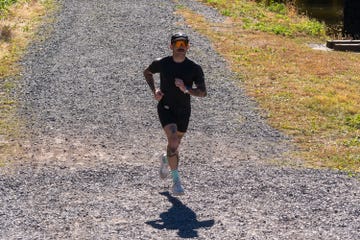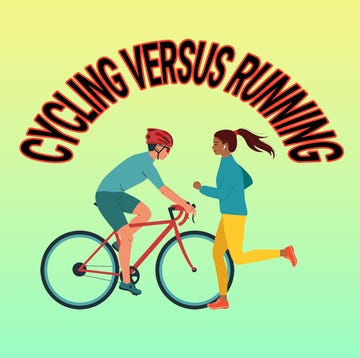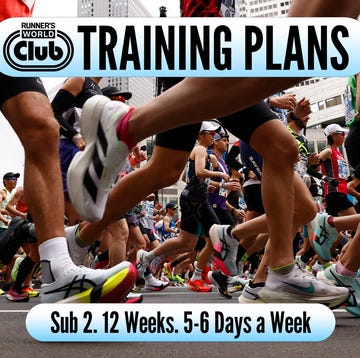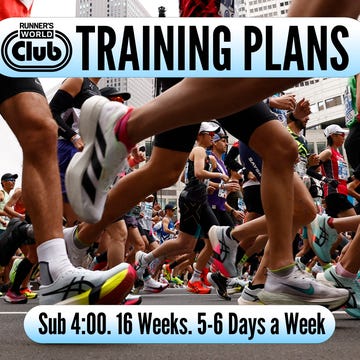The mile run has had a bit of a renaissance – and we’re here for it. Short enough to recruit those speed-focused fast-twitch muscle fibres, but long enough to require an element of pacing and strategy, the mile is an iconic running distance, even if – alas – it is not represented at the Olympic Games or World Championships.
In July 2025, Faith Kipyegon made a fantastic fanfare of the mile at her Breaking4 challenge, where she was less than seven seconds away from becoming the first woman in history to run a mile in under four minutes. For context, more than 2,000 elite-level men – which, in the grand scheme of things, is very few – have broken the four-minute barrier since Roger Bannister famously clocked the world’s first three-minute-something mile in 1954. As such, running a mile in under four minutes is a very rare feat – so please don’t be disappointed if your mile time, like most people’s, doesn’t come close to this.
But this begs the questions: what is a ‘normal’ finish time for a mile run? And how does your mile pace compare with the average? Here, we unravel some mile run statistics to help you see where you stand.
What everyone's reading
How far is far one mile?
An imperial unit of measurement, the mile is most commonly used as a marker of distance in the US and UK (although many Brits would hasten to say that they prefer to measure in kilometres). One mile is the equivalent of approximately 1.609km – and when you extrapolate this to the most popular race distances, 5K is about 3.1 miles, 10K about 6.2 miles, a half marathon about 13.1 miles and a marathon about 26.2 miles.
A mile also equates to 1760 yards, although it’s unlikely that you’ll ever be tested on your yard knowledge in the running world.
What is the average finish time for one mile?
In its latest Year in Sport report, which revealed results from the analysis of billions of activities uploaded to Strava over a 12-month period, plus a global survey of more than 5,000 active people, Strava published some interesting insights on our running pace. According to Strava’s findings, runners across the world run at an average pace of 10:15 min/mile (6:22 min/km), which means that it takes 10 minutes and 15 seconds for the average runner to complete the one-mile distance.
Garmin, meanwhile, found the average runner to be a little faster. Using its own data retrieved from runners, who in this instance are global Garmin users who have completed two or more runs per week for 75% of the year, the brand found the average running pace, worldwide, to be 9:06 min/mile (5:39 min/km).
The same Garmin study ranked countries by running speed. Irish runners came out on top, thanks to their average pace of 8:41 min/mile (5:24 min/km), while the UK placed 11th with a respectable average running pace of 8:58 min/mile (5:50 min/km).
What impacts your mile running pace?
Runners are not carbon copies of one another, even in carbon plate shoes, so it makes sense that we all run at difference paces – and even the same runner can achieve different speeds for different runs at different times and locations. As such, the average running paces noted above are broad estimates that can be influenced by a wide range of things.
Personal factors like your age and gender can impact your mile time. Younger adults, aged between 20 and 30, typically record the speediest mile times of all generations, while men are generally faster than women due to physiological differences. However, controllable factors like your training history, progress and commitment play a big part in running success, so your age and gender by no means dictate your race times and potential.
It’s also worth remembering that weather conditions can influence your running pace, with heat, humidity and wind being among the toughest conditions for runners. If you have to run when it’s hot and humid, it’s actually important to run at a slower pace – or to run indoors on a treadmill, if you can – and take additional precautions to avoid the risk of developing heat-related illnesses. Instead of fixating on pace, judge your runs according to effort.
The same goes for runs on difficult terrain, like rocky trails or uneven, hilly paths. Here, your mile pace will invariably be slower – and much more inconsistent – than it would be when you’re running on smooth, flat surfaces like a road or running track, so think about the effort that you’re putting in rather than the time and pace displayed on your running watch. Plus, your running pace for a standalone mile – especially if it’s a one-mile race – is likely to be quicker than your running pace for a longer run like a marathon, so the total distance that you’re running will have a bearing on your speed.
You also need to consider how well you’re doing in your own body. If you’re skimping on sleep, inadequately recovered from previous workouts, struggling with a niggle or injury, or fuelling and hydrating poorly, your running performance – and therefore your running pace – will almost certainly be affected. So, take the time that you need to rest, repair and restore your health before trying to go full pelt with mile training – because it will pay off.
What are the world records for the mile run?
We’ve mentioned her before and we’ll mention her again: Kipyegon. The fastest woman over the mile, the Kenyan athlete currently holds the official mile world record of 4:07.64, which she achieved in Monaco in 2023.
We are careful to note that this is the official world record, since Kipyegon’s result at Breaking4, 4:06.42, cannot be ratified by World Athletics. Since it was not an open competition and it involved male pacers, Breaking4 was an experiment – if not an exhibition event – to test human limits and technologies rather than reset official marks.
On the men’s side, Hicham El Guerrouj of Morocca still holds the one-mile record, having clocked 3:43.13 for the distance on the track in Rome, Italy more than a quarter of a century ago in 1999.
How can you improve your mile time?
Even if the thought of running a mile makes you want to, well, run a mile, it needn’t be a terrifying distance. Rather, it can be a lot of fun to run a mile as fast as you can – and training well for the event can assist your preparations for longer races, too.
To give yourself the best chance of running your fastest mile, it’s important to build regular speed sessions into your weekly training routine, alongside plenty of easy and recovery runs, consistent strength training and, of course, rest. For more tips, consult our one-mile training plan by leading running coach and RW columnist Tom Craggs – or, if you’re gunning for an especially speedy mile time of five minutes, glean the wisdom of RW’s Rick Pearson, who will be quick to share the story of his sub-5 feat.
Even better, join the Runner’s World Club to unlock customisable training plans and an exclusive bank of expert advice on how to pick up the pace for your next mile effort and beyond.













